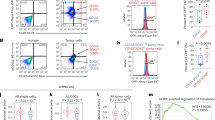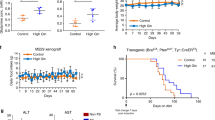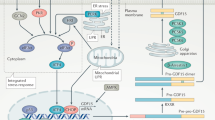Abstract
Widespread application of gene therapy will depend on the development of simple methods to regulate the expression of therapeutic genes. Here we harness an endogenous signaling pathway to regulate therapeutic gene expression through diet. The GCN2-eIF2α signaling pathway is specifically activated by deficiencies in any essential amino acid (EAA); EAA deficiency leads to rapid expression of genes regulated by ATF4-binding cis elements. We found that therapeutic genes under the control of optimized amino acid response elements (AAREs) had low basal expression and high induced expression. We applied our system to regulate the expression of TNFSF10 (TRAIL) in the context of glioma therapy and found that intermittent activation of this gene by EEA-deficient meals retained its therapeutic efficacy while abrogating its toxic effects on normal tissue. The GCN2-eIF2α pathway is expressed in many tissues, including the brain, and is highly specific to EAA deficiency. Our system may be particularly well suited for intermittent regulation of therapeutic transgenes over short or long time periods.
This is a preview of subscription content, access via your institution
Access options
Subscribe to this journal
Receive 12 print issues and online access
$209.00 per year
only $17.42 per issue
Buy this article
- Purchase on Springer Link
- Instant access to full article PDF
Prices may be subject to local taxes which are calculated during checkout




Similar content being viewed by others
References
Kaufmann, K.B., Büning, H., Galy, A., Schambach, A. & Grez, M. Gene therapy on the move. EMBO Mol. Med. 5, 1642–1661 (2013).
Benítez, J.A., Domínguez-Monzón, G. & Segovia, J. Conventional and gene therapy strategies for the treatment of brain tumors. Curr. Med. Chem. 15, 729–742 (2008).
Sheridan, C. Gene therapy finds its niche. Nat. Biotechnol. 29, 121–128 (2011).
Misra, S. Human gene therapy: a brief overview of the genetic revolution. J. Assoc. Physicians India 61, 127–133 (2013).
Maurin, A.C. et al. The GCN2 kinase biases feeding behavior to maintain amino acid homeostasis in omnivores. Cell Metab. 1, 273–277 (2005).
Chaveroux, C. et al. Molecular mechanisms involved in the adaptation to amino acid limitation in mammals. Biochimie 92, 736–745 (2010).
Kilberg, M.S., Balasubramanian, M., Fu, L. & Shan, J. The transcription factor network associated with the amino acid response in mammalian cells. Adv. Nutr. 3, 295–306 (2012).
Dever, T.E. et al. Phosphorylation of initiation factor 2 alpha by protein kinase GCN2 mediates gene-specific translational control of GCN4 in yeast. Cell 68, 585–596 (1992).
Lu, P.D., Harding, H.P. & Ron, D. Translation reinitiation at alternative open reading frames regulates gene expression in an integrated stress response. J. Cell Biol. 167, 27–33 (2004).
Vattem, K.M. & Wek, R.C. Reinitiation involving upstream ORFs regulates ATF4 mRNA translation in mammalian cells. Proc. Natl. Acad. Sci. USA 101, 11269–11274 (2004).
Bruhat, A. et al. Amino acids control mammalian gene transcription: activating transcription factor 2 is essential for the amino acid responsiveness of the CHOP promoter. Mol. Cell. Biol. 20, 7192–7204 (2000).
Harding, H.P. et al. An integrated stress response regulates amino acid metabolism and resistance to oxidative stress. Mol. Cell 11, 619–633 (2003).
Carraro, V. et al. Amino acid availability controls TRB3 transcription in liver through the GCN2/eIF2α/ATF4 pathway. PLoS One 5, e15716 (2010).
Donnelly, N., Gorman, A.M., Gupta, S. & Samali, A. The eIF2α kinases: their structures and functions. Cell. Mol. Life Sci. 70, 3493–3511 (2013).
Crosby, J.S., Lee, K., London, I.M. & Chen, J.J. Erythroid expression of the heme-regulated eIF-2 alpha kinase. Mol. Cell. Biol. 14, 3906–3914 (1994).
Chaveroux, C. et al. In vivo imaging of the spatiotemporal activity of the eIF2α-ATF4 signaling pathway: Insights into stress and related disorders. Sci. Signal. 8, rs5 (2015).
Ezzine, S. et al. RILES, a novel method for temporal analysis of the in vivo regulation of miRNA expression. Nucleic Acids Res. 41, e192 (2013).
Keller, T.L. et al. Halofuginone and other febrifugine derivatives inhibit prolyl-tRNA synthetase. Nat. Chem. Biol. 8, 311–317 (2012).
Pines, M. & Spector, I. Halofuginone - the multifaceted molecule. Molecules 20, 573–594 (2015).
Seol, J.Y. et al. Adenovirus-TRAIL can overcome TRAIL resistance and induce a bystander effect. Cancer Gene Ther. 10, 540–548 (2003).
Griffith, T.S. et al. TRAIL gene therapy: from preclinical development to clinical application. Curr. Gene Ther. 9, 9–19 (2009).
Bellail, A.C., Qi, L., Mulligan, P., Chhabra, V. & Hao, C. TRAIL agonists on clinical trials for cancer therapy: the promises and the challenges. Rev. Recent Clin. Trials 4, 34–41 (2009).
Kim, C.Y. et al. Preclinical studies for pharmacokinetics and biodistribution of Ad-stTRAIL, an adenovirus delivering secretable trimeric TRAIL for gene therapy. Exp. Mol. Med. 43, 580–586 (2011).
Nagane, M., Cavenee, W.K. & Shiokawa, Y. Synergistic cytotoxicity through the activation of multiple apoptosis pathways in human glioma cells induced by combined treatment with ionizing radiation and tumor necrosis factor-related apoptosis-inducing ligand. J. Neurosurg. 106, 407–416 (2007).
Walczak, H. et al. Tumoricidal activity of tumor necrosis factor-related apoptosis-inducing ligand in vivo. Nat. Med. 5, 157–163 (1999).
Nitsch, R. et al. Human brain-cell death induced by tumour-necrosis-factor-related apoptosis-inducing ligand (TRAIL). Lancet 356, 827–828 (2000).
Nesterov, A., Ivashchenko, Y. & Kraft, A.S. Tumor necrosis factor-related apoptosis-inducing ligand (TRAIL) triggers apoptosis in normal prostate epithelial cells. Oncogene 21, 1135–1140 (2002).
Volkmann, X. et al. Increased hepatotoxicity of tumor necrosis factor-related apoptosis-inducing ligand in diseased human liver. Hepatology 46, 1498–1508 (2007).
Hingtgen, S. et al. Targeting multiple pathways in gliomas with stem cell and viral delivered S-TRAIL and Temozolomide. Mol. Cancer Ther. 7, 3575–3585 (2008).
Agha-Mohammadi, S. & Lotze, M.T. Regulatable systems: applications in gene therapy and replicating viruses. J. Clin. Invest. 105, 1177–1183 (2000).
Mortimore, G.E. & Pösö, A.R. Intracellular protein catabolism and its control during nutrient deprivation and supply. Annu. Rev. Nutr. 7, 539–568 (1987).
Goverdhana, S. et al. Regulatable gene expression systems for gene therapy applications: progress and future challenges. Mol. Ther. 12, 189–211 (2005).
Naidoo, J. & Young, D. Gene regulation systems for gene therapy applications in the central nervous system. Neurol. Res. Int. 2012, 595410 (2012).
Bartus, R.T., Weinberg, M.S. & Samulski, R.J. Parkinson's disease gene therapy: success by design meets failure by efficacy. Mol. Ther. 22, 487–497 (2014).
Di Stasi, A. et al. Inducible apoptosis as a safety switch for adoptive cell therapy. N. Engl. J. Med. 365, 1673–1683 (2011).
Ron, D. & Walter, P. Signal integration in the endoplasmic reticulum unfolded protein response. Nat. Rev. Mol. Cell Biol. 8, 519–529 (2007).
O'Connor, T. et al. Phosphorylation of the translation initiation factor eIF2alpha increases BACE1 levels and promotes amyloidogenesis. Neuron 60, 988–1009 (2008).
Hoozemans, J.J. et al. Activation of the unfolded protein response in Parkinson's disease. Biochem. Biophys. Res. Commun. 354, 707–711 (2007).
Shah, K., Tang, Y., Breakefield, X. & Weissleder, R. Real-time imaging of TRAIL-induced apoptosis of glioma tumors in vivo. Oncogene 22, 6865–6872 (2003).
Harding, H.P., Zhang, Y., Bertolotti, A., Zeng, H. & Ron, D. Perk is essential for translational regulation and cell survival during the unfolded protein response. Mol. Cell 5, 897–904 (2000).
Harding, H.P. et al. Regulated translation initiation controls stress-induced gene expression in mammalian cells. Mol. Cell 6, 1099–1108 (2000).
Abraham, N. et al. Characterization of transgenic mice with targeted disruption of the catalytic domain of the double-stranded RNA-dependent protein kinase, PKR. J. Biol. Chem. 274, 5953–5962 (1999).
Maurin, A.C. et al. Hypothalamic eIF2α signaling regulates food intake. Cell Rep. 6, 438–444 (2014).
Acknowledgements
We thank K. Shah (Harvard Medical School) for Gli36-Luc cells, D. Ron and H. Harding (Institute of Metabolic Science, Cambridge, UK) for GCN2−/− and PERK−/− MEFs, J.C. Bell (Ottawa health research institute, Canada) for PKR−/− MEFs, M. Petera for statistical analysis assistance, and A. Terrisse and A Teygnié for animal care and technical assistance. This study was supported by 'Programmes Emergence' (ANR-12-EMMA-0024) and (ANR-12-BSV2-0025-03) of 'Agence Nationale de la Recherche'.
Author information
Authors and Affiliations
Contributions
C.C., A.B., J.M. and P.F. designed the experiment; C.C., A.B., V.C., A.M., P.B., A.D.T. and P.R. performed the experiments; P.C. supervised A.M.'s work; J.A., A-C.M., L.P., C.J., Y.M. and F.M. provided reagents, materials, or analysis tools; C.C., P.F., J.M., P.R. and A.B. analyzed the data; J.M., A.B. and P.F. wrote the paper.
Corresponding author
Ethics declarations
Competing interests
P.F., A.B., C.J., A.-C.M. and J.A. are authors of patent application WO/2013/068096 (also US14357160A1 and EP2776568), “Inducible Expression Cassette, And Uses Thereof.”
Integrated supplementary information
Supplementary Figure 1 Generation of the AARE-Gene system construct.
(a) Position and sequence alignment of AAREs extracted from human Trb3, Chop or Atf3 promoters. AARE core sequences are boxed in grey. (b) Comparison of strength of AAREs from Trb3, Chop or Atf3 promoters in response to Leucine starvation. MEFs were transiently transfected with constructs containing two copies of each AARE. Twenty-four hours after transfection, cells were incubated for 16 h in control or medium lacking leucine and assayed for luciferase activity (Student's t-test: ***p <0.001, n=9; error bars: means ± s.e.m.). (c) The TK minimal promoter provides a lower baseline level compared to the β- globin one. MEFs were transiently transfected with Luc constructs containing two copies of AAREs from Trb3 promoter and a minimal promoter coming from either the TK or β-globin gene. Twenty-four hours after transfection, cells were incubated for 16 h in control or medium lacking leucine and assayed for luciferase activity (Student's t-test: ***p <0.001, n=9; error bars: means ± s.e.m.). (d) Mouse Embryonic Fibroblasts (MEF) or HeLa cells stably transduced with LV-AARE-Luc lentiviral vector were incubated for 16 h either in control (Ctrl) or leucine-free medium (-Leu) and assayed for luciferase activity (Student's t-test: ***p <0.001, n=9; error bars: means ± s.e.m.).
Supplementary Figure 2 GCN2 requirement for the AARE-Driven Expression System inducibility by leucine starvation.
(a) Wild type (WT), GCN2 -/-, PERK -/- or PKR -/- MEFs were transiently transfected with the construction described above. Twenty-four hours after transfection, cells were leucine-starved for 16 h and assayed for luciferase activity (Student's t-test: ***p <0.001, n=9; error bars: means ± s.e.m.). (b) Leucine concentration response of the AARE-Gene system inducibility. MEFs were transiently transfected with the AARE-Luc construction. Twenty-four hours after, cells were incubated for 16 h in media containing decreasing concentrations of leucine and assayed for luciferase activity (Student's t-test: ***p <0.001 in comparison to the control condition (420 μM), n=9; error bars: means ± s.e.m.).
Supplementary Figure 3 Consumption of a diet devoid of one essential amino acid causes a drop of the corresponding EAA in the plasma.
Following an overnight fasting period, AARE-Luc transgenic mice were fed for 6 hours, a control diet (Ctrl) or a diet devoid of alanine (-Ala), or histidine (-His), or isoleucine (-Ile), or methionine (-Met), or leucine (-Leu), or lysine (-Lys), or phenylalanine (-Phe), or threonine (-Thr), or tryptophan (-Trp), or valine (-Val). At the end of the experiments, blood was collected and amino acid measurement was performed for the different nutritional conditions (Student's t-test: ***p <0.001, n=6 male mice; error bars: means ± s.e.m.).
Supplementary Figure 4 Identification of the target tissues of the eIF2α-ATF4 pathway induction in transgenic mice, in which the AARE-gene expressing luciferase was stably integrated.
Mice were fed on a complete or a leucine-deficient diet for 6 h. Mice were sacrificed by cervical dislocation and organs were rapidly excised followed by snap-freezing for subsequent luciferase activity measurement. Results are given as fold induction relative to the control condition arbitrary set at 1 for each analyzed organ (Student's t-test: *p <0.05, **p <0.01, ***p <0.001 in comparison to the control condition, n=6 male mice; error bars: means ± s.e.m.).
Supplementary Figure 5 Assessment by bioluminescence imaging of the lentivirus dissemination in the mouse body following pancreatic transduction with LV-AARE-Luc.
(a) Administration of lentiviral particles containing the AARE-TK-Luc was performed into the pancreas of wild type mice. Ten days after injection, mice were challenged with the nutritional protocol (-Ile diet) for 6h and bioluminescence was measured. After pancreas and the adjacent spleen have been collected, organs and the body were imaged for bioluminescence. (b) PCR amplification for genotyping of the spleen and pancreas collected in Figure Supplementary 5a (primers used for PCR: forward primer, 5′-TCTGGTGGCGCTCCCCTCTC-3′; reverse primer, 5′-AACAACAACGGCGGCGGGAA-3′).
Supplementary Figure 6 Induction of the AARE-Driven Expression system by halofuginone in liver and pancreas.
Halofuginone (Hf) exerts its effects by acting as a high affinity inhibitor of the enzyme Glutamyl-Prolyl tRNA synthetase. Inhibition of prolyl tRNA charging leads to the accumulation of uncharged prolyl tRNAs, which serves as a signal to initiate the amino acid starvation response. Hf has anti-metastatic and anti-proliferative effects. It has already been used to treat patients with solid tumor, unfortunatly with low antitumor effects and few side effects (nosea, vomiting, fatigue…) (De Jonge et al 2006; European J of Cancer 42; 1768-1774). (a) Bioluminescence imaging of mice following hydrodynamics-based DNA injection of the pGL3-AARE-Luc. Wild type mice received 25 micrograms of plasmid according to the hydrodynamic injection method. Twenty-four hours later, mice were injected with Hf (0.05μg/g of body weight) or PBS (Ctrl). Bioluminescence imaging was performed 6 hours after injection and light emission quantified using ROIs covering the abdominal area (red shape) (Student's t-test: ***p <0.001 versus Control (Ctrl), n=6 male mice; error bars: means ± s.e.m.). Signal intensity as a result of photon detection is graded from red (highest number of photons) to blue (lowest intensity). Next the livers have been collected and imaged for bioluminescence and then the corresponding protein homogenates were assayed for luciferase activity determination (Student's test: ***p <0.001 versus Control diet, n=6 male mice; error bars: means ± s.e.m.). (b) Intra-pancreatic delivery and induction of the AARE-Luc by halofuginone following lentiviral transduction. Administration of lentiviral particles containing the AARE-TK-Luc (LV-AARE-Luc) was performed into the pancreas of wild type mice. Ten days after injection, mice were injected with halofuginone (Hf) or PBS (Ctrl). Light emission was quantified 6 h after injection using ROIs covering the pancreatic area (red shape). Signal intensity as a result of photon detection is graded from red (highest number of photons) to blue (lowest intensity). (Student's t-test: **p <0.01 versus Control (Ctrl), n=6 male mice; error bars: means ± s.e.m.). Then the pancreas have been collected and imaged for bioluminescence and the corresponding protein homogenates were assayed for luciferase activity determination (Student's t-test: ***p <0.001 versus Control (Ctrl), n=6 male mice; error bars: means ± s.e.m.).
Supplementary Figure 7 Apoptosis induction through the AARE-Gene mediated expression of TRAIL in human glioblastoma cells.
(a) Scheme for the AARE-Gene expression system driving either eGFP (LV-AARE-eGFP) or TRAIL (LV-AARE-TRAIL) expression. The corresponding lentiviral particles were then used for the following experiments. (b) Time course analysis of cell death induction in human glioblastoma cells expressing TRAIL under the control of the AARE-Gene system. Gli36-luc cells were transduced with the lentiviral particles described above. Forty-eight hours post-transduction, cells were incubated in control medium (Ctrl) or medium without leucine (-Leu) for the indicated time periods. TRAIL, cleaved-PARP (marker of apoptosis, short and long exposure), and ATF4 levels were analyzed by western blot. Actin levels are shown as a loading control. (c) Monitoring of apoptosis induction in glioblastoma cells following TRAIL expression in response to an EAA starvation. LV-AAREeGFP or LV-AARE-TRAIL Gli36-luc cells were incubated in control (Ctrl) or leucine-deprived (-Leu) medium for 4-24 h and then stained with 7-AAD and Annexin V for subsequent FACS analysis. (d) Quantification of TRAIL release by Gli36-luc cells following TRAIL expression in response to a leucine starvation. LV-AARE-eGFP or LV-AARE-TRAIL Gli36-luc cells were incubated in control medium (white bars) or starved for leucine (black bars) for 16 h. Quantification of TRAIL concentrations in the media was performed by ELISA (Student's t-test: ***p <0.001, n=9; error bars: means ± s.e.m.). (e) Paracrine effect of secreted TRAIL. Parental cells were incubated for 16 h with media collected in Supplementary Figure 7d. Cleaved-PARP and ATF4 levels were analyzed by western blot. Actin levels are shown as a loading control.
Supplementary Figure 8 Growth of xenografted glioblastoma cells is not impaired in mice fed diets devoid of one EAA.
(a) 2x106 Gli36-luc cells were implanted subcutaneously in nude mice. A week after, mice were divided into two groups: one fed a control diet and a second group fed with an alternation of EAA-deficient diets as described in figure 2C. For tumor growth monitoring, mice bearing tumors were imaged on the first day after Gli36-luc implantation (T0) and subsequently every week. Signal intensity within the region of interest was quantified using ROIs covering the tumors. Photon detection is graded from red (highest number of photons) to blue (lowest intensity). No significant difference was observed for radiance, between the 2 groups along the time. (b) Tumors weight analysis. At the end of the experiment, excised tumors were photographed and weighted. No significant difference was observed for tumor weight, between the 2 groups along the time. (c) Nutritional control of the GCN2-eIF2α-ATF4 pathway. At the end of the experiment, tumors from the Ctrl group fed a complete diet (Ctrl/Ctrl) were excised at day 21. Within the -EAA group, half of the lot was sacrificed at day 21 whereas the other half was killed a day later. For more details see legend of Figure 4. Proteins homogenates from the excised tumors were analyzed by western blot for detection of P-eIF2α and ATF4 levels. Actin levels are shown as a loading control.
Supplementary information
Supplementary Text and Figures
Supplementary Figures 1–8 (PDF 1470 kb)
Supplementary Table 1
Composition of the experimental diets (PDF 159 kb)
Rights and permissions
About this article
Cite this article
Chaveroux, C., Bruhat, A., Carraro, V. et al. Regulating the expression of therapeutic transgenes by controlled intake of dietary essential amino acids. Nat Biotechnol 34, 746–751 (2016). https://doi.org/10.1038/nbt.3582
Received:
Accepted:
Published:
Issue Date:
DOI: https://doi.org/10.1038/nbt.3582
This article is cited by
-
Blockade of IDO-kynurenine-AhR metabolic circuitry abrogates IFN-γ-induced immunologic dormancy of tumor-repopulating cells
Nature Communications (2017)
-
An edible switch for gene therapy
Nature Biotechnology (2016)



